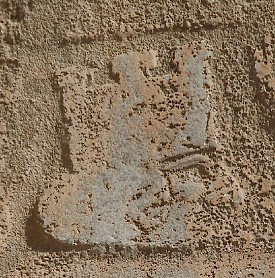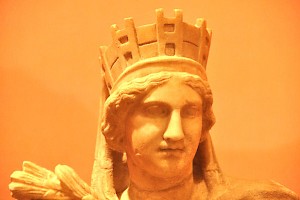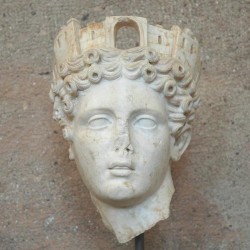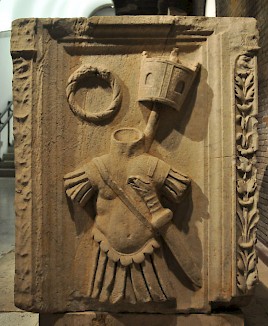Mural Crown
Mural Crown: artistic motif from the ancient Near East, also used in Hellenistic and Roman art.

The oldest depictions of mural crowns can be found in the second millennium BCE, in Assyria and Elam. Among the people depicted with this object is queen Aššur-šarrat, the wife of the Assyrian king Aššurbanipal (r.668-631), on a relief that is now in Berlin.
Another early representation can be found in Naqš-e Rustam, where fragments of a very ancient relief have survived near a relief that commemorates the Sassanian king Bahram II (r.276-294). Because a part of the old relief is now lost, we do not know whether the crowned lady is a queen or a deity.

The mural crown was introduced into Greek art by Eutychides of Sicyon (c.335-c.275), a pupil of the great Lysippus, and the creator of the famous statue of the Tyche of Antioch. This work of art became very famous, and influenced other statues of protective city deities. Some copies of the statue of Artemis of Ephesus wear a mural crown too; the object also crowns the head of nearly all statues of Cybele.
 Aššur-šarrat |
 Corinth, Temple E, Portrait of Octavia as Tyche |
 Baalbek, Temple of Bacchus, Ceiling |
 Coat of arms of Saint-Augustine (Florida) |

In the Roman empire, a crown in the shape of a wall was awarded to the first soldier who scaled the wall of a besieged city.note It was made of gold, and was considered to be a very important decoration. The emperor Augustus tried to donate these as sparingly as possible, to maintain the extraordinary value.note
Nevertheless, mural crowns remained in use as symbols of cities. When in Baalbek the temple of Bacchus was constructed, the towns that had contributed to the project, were represented with heads with mural crowns. Not in the shrine itself, though, which was reserved for the god himself: the crowned ladies can be seen in the corridor between the outer wall of the temple and the columns.
In the Middle Ages, the symbol disappeared. However, as crown of the statue of the goddess of the city's fortune, the mural crown became popular again in the Renaissance, not only on statues, but also as a heraldic symbol. Many cities in Europe and its former colonies have a mural crown on top of their coat of arms.